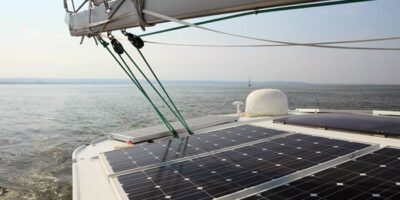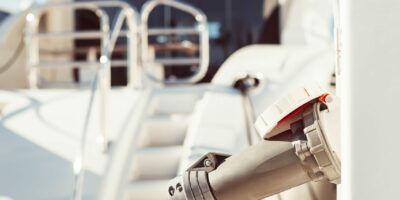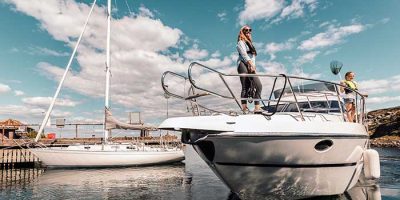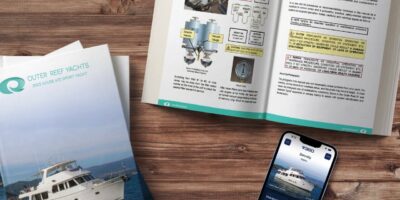Onboard Electrical Hazards
There are plenty of ways electricity can create havoc on a boat. A longtime marine surveyor walks you through the problem areas.
- January 22, 2024
1. Incorrectly sized fuses can cause a fire.
2. Corroded or broken wires can introduce DC power into bilge water, resulting in accelerated corrosion issues.
Inspect connections for corrosion or failure. Bilge pumps typically come with extra-long leads to allow you to locate the connections as high as possible from the normal accumulation of bilge water. You’ll also want to verify that each pump is properly protected by an appropriately sized fuse or breaker.
Electronics
1. Loose or corroded connections can cause intermittent electronics operation.
2. Broken wires can render electronics inoperative.
Inspect all connectors, terminal strips, and fuse holders regularly for loose screws, broken wires, and corrosion. Bad connections cause more problems with electronics than any other issue. Application of dielectric grease or other suitable corrosion inhibitor after cleaning will help prevent corrosion, as will the use of only marine grade connectors and components.
Windlass
1. Loose or corroded electrical connections can cause intermittent operation.
2. Inadequate wire size can damage the windlass or possibly cause a fire.
Inspect electrical connections for problems, such as corrosion or charring. Verify wire is proper size.
Dissemble and clean corroded connections (after turning off all power) with a wire brush and electrical cleaner. Terminal and post connections should be clean and tight — coating them with dielectric grease and installing insulating rubber boots will protect against corrosion and accidental shorting. Foredeck foot switches should also be inspected for corrosion, broken connectors, and chafed wires, all of which can result in improper operation.
Batteries
1. Loose or corroded battery terminal connections can result in problems such as shortened battery life (due to improper charging) or equipment operation issues due to low voltages.
2. Accidentally shorting the battery can result in fires or even explosion.
Loose or corroded battery cables and terminals are the root of many DC system problems. Inspect all battery terminals and connectors for corrosion, loose hardware, or broken wires.
Clean all battery tops and posts of corrosion with a rag dipped in a solution of water and baking soda (a couple of tablespoons to a pint of water), and dry afterward with a clean rag. For extreme corrosion, pull terminal connectors, brighten both the battery post and inside of the connector with a wire brush, then reinstall and spray with a good marine corrosion inhibitor (Boeshield’s T-9 Spray Lube, CRC Battery Terminal Protector). Positive battery posts must be covered as per ABYC guidelines, to prevent accidental shorting.
Connections
Corrosion can occur when connections are not protected with heat shrink or sealant.
Wire nuts or tape joints can fail, causing arcing and shock hazards.
All connectors should be crimp-on type, preferably with attached heat-shrink tubing to prevent moisture entry and corrosion. Replace all electrical tape joints, as well as any using household type twist-on connectors — both will eventually fall off, leaving exposed, energized conductors.
DC Electrical Panel
1. Loose or damaged DC system components can cause equipment damage and even fires.
2. Worn breakers can trip easily, causing circuit shutdown.
Replace breakers with a worn or loose feel. After securing all power sources (breakers and battery switches in the off position, for both DC and AC current, and verifying this with volt/ohm meter), open and inspect the DC panel for problems, such as corrosion, charred terminals, broken wires, or exposed conductors. Check all breakers and fuse holders (ensuring everything is tight and secure), and neaten up wiring behind the panel using wire ties or other wire-management tools.
Tip: When working in an electrical panel box, both AC and DC power should be turned off, whether you’re checking an AC or DC circuit. AC should be unplugged from dock and turned off at the inverter and other sources.
AC Breaker Panel
1. Loose or damaged components can generate anything from shocks to electrical fires.
Replace any breakers with a worn or loose feel. Turn off and unplug all power (dockside and vessel AC breakers, inverters, auto-start generators, and any other source and verify this with a volt/ohm meter and also turning off DC breakers), then open the panel and inspect it for corrosion, charred terminals, and broken wires. Ensure all breaker mounting hardware is tight.
AC Shore Power Cord Inlets And Plugs
1. Charred or overheating AC inlets and plugs are a common source of AC system fires.
2. Damaged cables can cause shocks.
First, turn off your boat’s main AC breaker, then the shore pedestal breaker. Next unplug the AC shore power cord at both ends and lay it on the dock. Check the power cord for chafe, cracks, split insulation, or repairs. Check plugs and inlets (both at the boat and dock) for discoloration (due to overheating) or corrosion on or around pins and plug inlets. This should be done each time you disconnect shore power or monthly at a minimum. Turning off the power at the dock pedestal before plugging or unplugging the cord to the boat will eliminate damage to the pins from arcing.
Wiring
1. Unsupported wires and cables can result in broken connectors and intermittent problems.
2. Solid copper wire can break, resulting in arcing and possibly fire.
Look for poorly installed wire runs, damaged conductors, and chafe points. Ensure wiring is correctly sized for the job it’s doing and supported at least every 18 inches with nonmetallic supports, except in the engine room where metallic wire supports are required. Solid copper wire is not acceptable as it is susceptible to breakage due to vibration.
Bonding System
1. Corroded or broken bonding wires provide no corrosion protection and can even encourage corrosion by creating a difference of potential between components of the “bonded” system.
All connections must be tight and corrosion-free for the system to work properly. One that’s improperly maintained or installed will provide the worst of both “to bond or not to bond” worlds.
Sterndrive Corrosion
1. Missing zincs or damaged corrosion protection systems can cause severe corrosion damage to your sterndrive.
If your marina neighbors have grounding, bonding, or other such wiring issues, your aluminum drive will act like a huge sacrificial anode to protect their below-the-waterline metals. Missing anodes or a corrosion-protection system with broken wires or corroded connections provide no protection.
Frank Lanier
Contributor, BoatUS Magazine
About Vessel Vanguard
Vessel Vanguard is a leading marine safety and maintenance management software provider dedicated to revolutionizing the maritime industry. With a commitment to innovation and excellence, Vessel Vanguard delivers cutting-edge solutions to streamline operations and enhance vessel performance and safety.
Latest Industry Insights

Embracing E-Boating Efficiencies

Boat Fuel Systems

The Future of Boats & Boating

Yacht Navigation Light Inspection
View All of Our Industry Insights
Navigate maritime with the latest news, practical how-to guides, insightful analyses and more.
